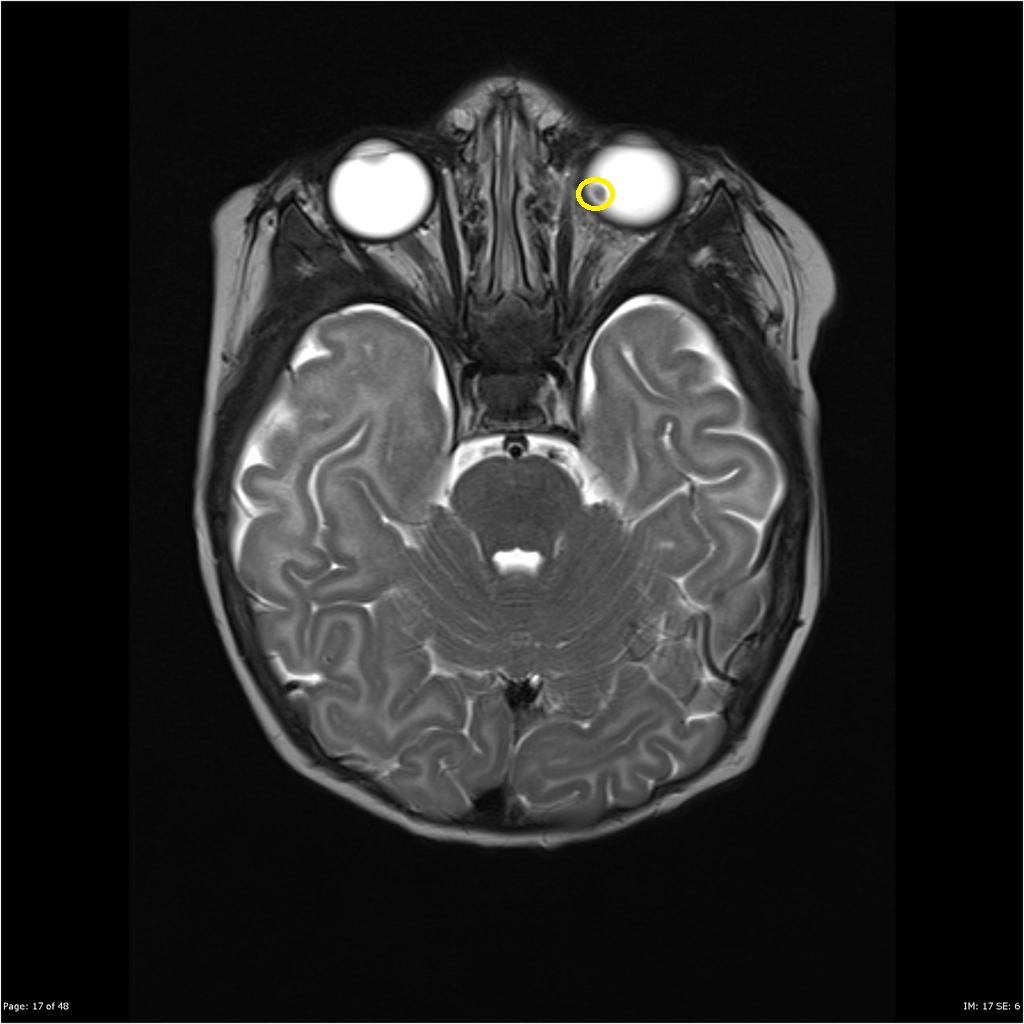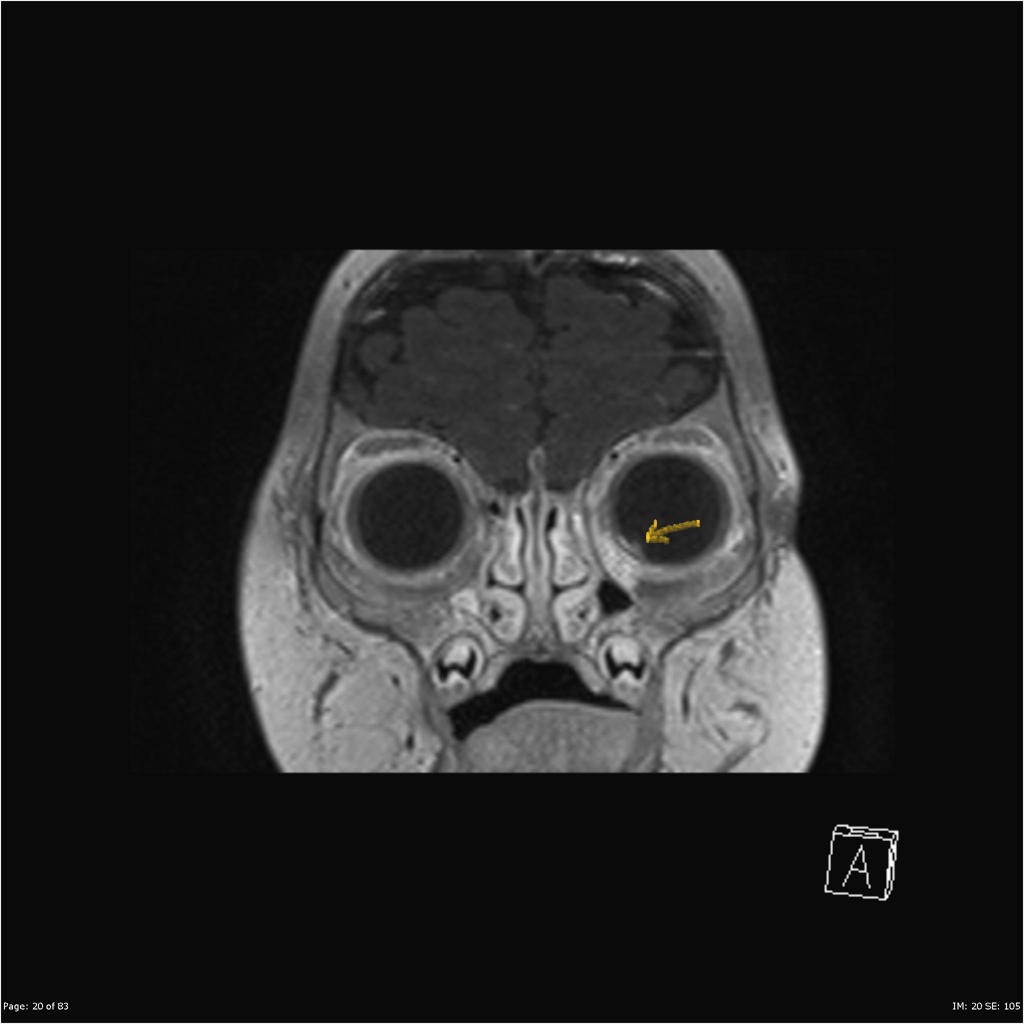Retinoblastoma MRI: Difference between revisions
Jump to navigation
Jump to search
Simrat Sarai (talk | contribs) |
m (Bot: Removing from Primary care) |
||
| (25 intermediate revisions by 4 users not shown) | |||
| Line 1: | Line 1: | ||
__NOTOC__ | __NOTOC__ | ||
{{Retinoblastoma}} | {{Retinoblastoma}} | ||
{{CMG}}{{AE}}{{Simrat}} | {{CMG}}; {{AE}} {{Sahar}} {{Simrat}} | ||
==Overview== | ==Overview== | ||
[[Magnetic resonance imaging|MRI]] findings of retinoblastoma include hyperintense [[mass]] on T1-weighted [[MRI]] and hypointense [[mass]] on T2-weighted [[MRI]]. | |||
==MRI== | ==MRI== | ||
[[MRI]] | *[[Magnetic resonance imaging|MRI imaging study]] of retinoblastoma was first introduced in1980.<ref name="Schueler2003">{{cite journal|last1=Schueler|first1=A O|title=High resolution magnetic resonance imaging of retinoblastoma|journal=British Journal of Ophthalmology|volume=87|issue=3|year=2003|pages=330–335|issn=00071161|doi=10.1136/bjo.87.3.330}}</ref> | ||
* | *[[MRI]] is [[Accuracy|accurate]] for [[tumor]] [[Cancer staging|staging]] and evaluation of [[metastatic]] [[risk factors]].<ref name="de GraafBarkhof2005">{{cite journal|last1=de Graaf|first1=Pim|last2=Barkhof|first2=Frederik|last3=Moll|first3=Annette C.|last4=Imhof|first4=Saskia M.|last5=Knol|first5=Dirk L.|last6=van der Valk|first6=Paul|last7=Castelijns|first7=Jonas A.|title=Retinoblastoma: MR Imaging Parameters in Detection of Tumor Extent|journal=Radiology|volume=235|issue=1|year=2005|pages=197–207|issn=0033-8419|doi=10.1148/radiol.2351031301}}</ref> | ||
{| | *It is also used as an additional [[diagnostic]] tool in suspected retinoblastoma cases.<ref name="pmid22988349">{{cite journal |vauthors=Meel R, Radhakrishnan V, Bakhshi S |title=Current therapy and recent advances in the management of retinoblastoma |journal=Indian J Med Paediatr Oncol |volume=33 |issue=2 |pages=80–8 |date=April 2012 |pmid=22988349 |pmc=3439795 |doi=10.4103/0971-5851.99731 |url=}}</ref> | ||
| | *[[MRI|MRI's]] [[Diagnosis|diagnostic]] value in the [[diagnosis]] of advanced retinoblastoma is greater than [[CT scan]].<ref name="de Jongde Graaf2014">{{cite journal|last1=de Jong|first1=Marcus C.|last2=de Graaf|first2=Pim|last3=Noij|first3=Daniel P.|last4=Göricke|first4=Sophia|last5=Maeder|first5=Philippe|last6=Galluzzi|first6=Paolo|last7=Brisse|first7=Hervé J.|last8=Moll|first8=Annette C.|last9=Castelijns|first9=Jonas A.|title=Diagnostic Performance of Magnetic Resonance Imaging and Computed Tomography for Advanced Retinoblastoma|journal=Ophthalmology|volume=121|issue=5|year=2014|pages=1109–1118|issn=01616420|doi=10.1016/j.ophtha.2013.11.021}}</ref> | ||
| | *[[MRI]] findings [[diagnostic]] of retinoblastoma are: | ||
**'''On T1 image:''' Hyperintense [[mass]] compared to [[vitreous body]] | |||
**'''On T2 image:''' Hypointense [[mass]] compared to [[vitreous body]] | |||
*[[Magnetic resonance imaging|MRI]] can differentiate the [[tumor]] with secondary [[retinal detachment]] from other [[causes]] of subretinal effusion or [[Retinal detachment|detachment]], such as [[Coats disease|Coats' disease]], primary hyperplastic [[vitreous]], and [[retinopathy of prematurity]]. | |||
*Also, some experts argue that [[CT-scans|CT imaging studies]] in [[bilateral]] retinoblastoma will increase the risk of future [[malignancies]]. [[MRI]] is not associated with such risk. | |||
*[[MRI]] is also the study of choice to rule out extra-[[ocular]] extension of the [[tumor]].<ref name="pmid22988349">{{cite journal |vauthors=Meel R, Radhakrishnan V, Bakhshi S |title=Current therapy and recent advances in the management of retinoblastoma |journal=Indian J Med Paediatr Oncol |volume=33 |issue=2 |pages=80–8 |date=April 2012 |pmid=22988349 |doi=10.4103/0971-5851.99731 |url=}}</ref> | |||
{| | |||
|[[image:Retinoblastoma-edited.jpg|thumb|400px|T2 image, Case courtesy of Dr Jeremy Jones, Radiopaedia.org, rID: 22114]] | |||
<br style="clear:left" /> | |||
|- | |- | ||
| | |} | ||
{| | |||
|[[image:Retinoblastoma-5 edited.jpg|thumb|400px|T1 image, Case courtesy of Dr Jeremy Jones, Radiopaedia.org, rID: 22114]] | |||
<br style="clear:left" /> | |||
| | |||
| | |||
| | |||
|- | |- | ||
|} | |} | ||
==References== | ==References== | ||
{{reflist|2}} | {{reflist|2}} | ||
[[Category: | [[Category:Medicine]] | ||
[[Category: | [[Category:Oncology]] | ||
[[Category: | [[Category:Up-To-Date]] | ||
[[Category:Surgery]] | |||
Latest revision as of 23:59, 29 July 2020
|
Retinoblastoma Microchapters |
|
Diagnosis |
|---|
|
Treatment |
|
Case Studies |
|
Retinoblastoma MRI On the Web |
|
American Roentgen Ray Society Images of Retinoblastoma MRI |
Editor-In-Chief: C. Michael Gibson, M.S., M.D. [1]; Associate Editor(s)-in-Chief: Sahar Memar Montazerin, M.D.[2] Simrat Sarai, M.D. [3]
Overview
MRI findings of retinoblastoma include hyperintense mass on T1-weighted MRI and hypointense mass on T2-weighted MRI.
MRI
- MRI imaging study of retinoblastoma was first introduced in1980.[1]
- MRI is accurate for tumor staging and evaluation of metastatic risk factors.[2]
- It is also used as an additional diagnostic tool in suspected retinoblastoma cases.[3]
- MRI's diagnostic value in the diagnosis of advanced retinoblastoma is greater than CT scan.[4]
- MRI findings diagnostic of retinoblastoma are:
- On T1 image: Hyperintense mass compared to vitreous body
- On T2 image: Hypointense mass compared to vitreous body
- MRI can differentiate the tumor with secondary retinal detachment from other causes of subretinal effusion or detachment, such as Coats' disease, primary hyperplastic vitreous, and retinopathy of prematurity.
- Also, some experts argue that CT imaging studies in bilateral retinoblastoma will increase the risk of future malignancies. MRI is not associated with such risk.
- MRI is also the study of choice to rule out extra-ocular extension of the tumor.[3]

|

|
References
- ↑ Schueler, A O (2003). "High resolution magnetic resonance imaging of retinoblastoma". British Journal of Ophthalmology. 87 (3): 330–335. doi:10.1136/bjo.87.3.330. ISSN 0007-1161.
- ↑ de Graaf, Pim; Barkhof, Frederik; Moll, Annette C.; Imhof, Saskia M.; Knol, Dirk L.; van der Valk, Paul; Castelijns, Jonas A. (2005). "Retinoblastoma: MR Imaging Parameters in Detection of Tumor Extent". Radiology. 235 (1): 197–207. doi:10.1148/radiol.2351031301. ISSN 0033-8419.
- ↑ 3.0 3.1 Meel R, Radhakrishnan V, Bakhshi S (April 2012). "Current therapy and recent advances in the management of retinoblastoma". Indian J Med Paediatr Oncol. 33 (2): 80–8. doi:10.4103/0971-5851.99731. PMC 3439795. PMID 22988349.
- ↑ de Jong, Marcus C.; de Graaf, Pim; Noij, Daniel P.; Göricke, Sophia; Maeder, Philippe; Galluzzi, Paolo; Brisse, Hervé J.; Moll, Annette C.; Castelijns, Jonas A. (2014). "Diagnostic Performance of Magnetic Resonance Imaging and Computed Tomography for Advanced Retinoblastoma". Ophthalmology. 121 (5): 1109–1118. doi:10.1016/j.ophtha.2013.11.021. ISSN 0161-6420.